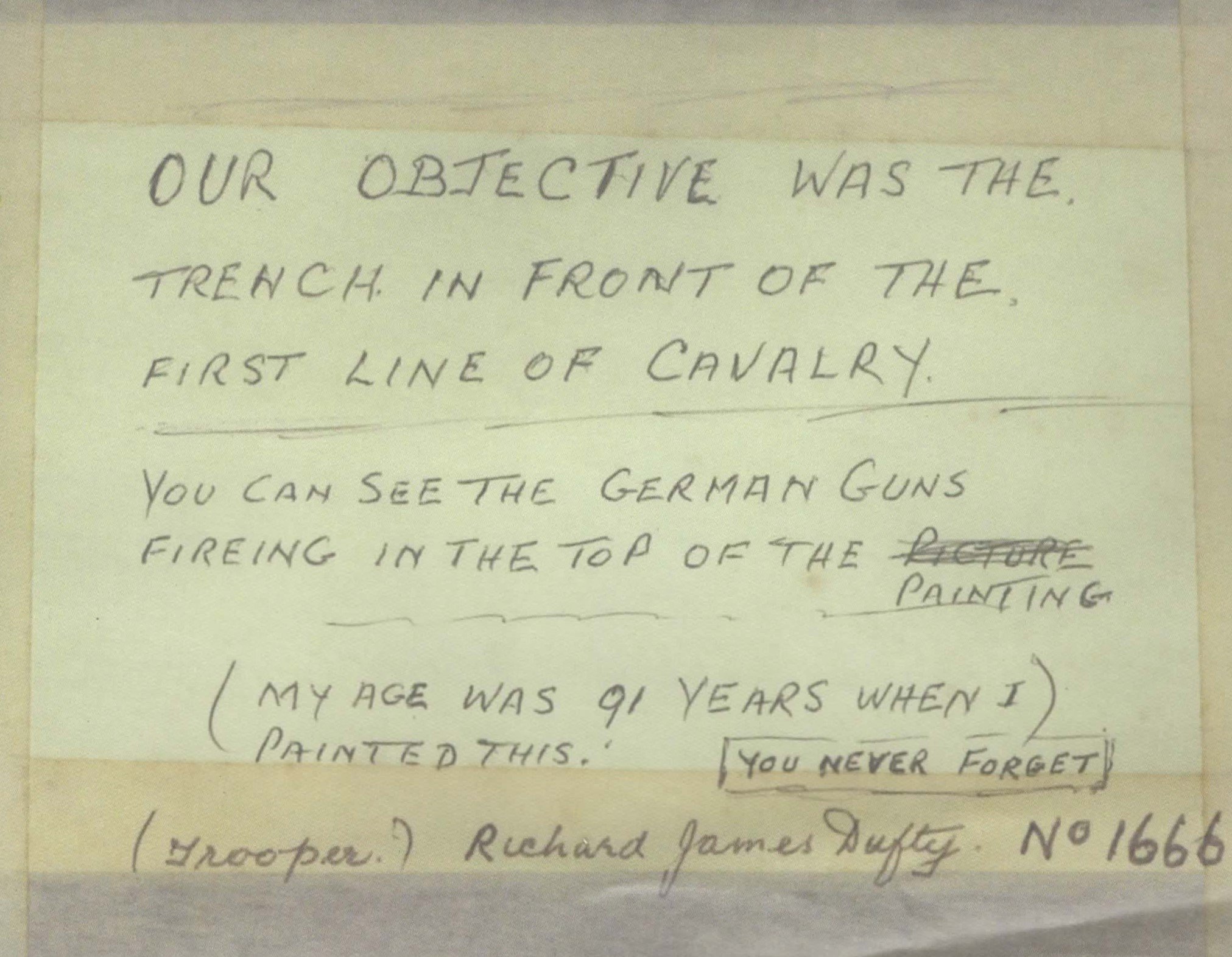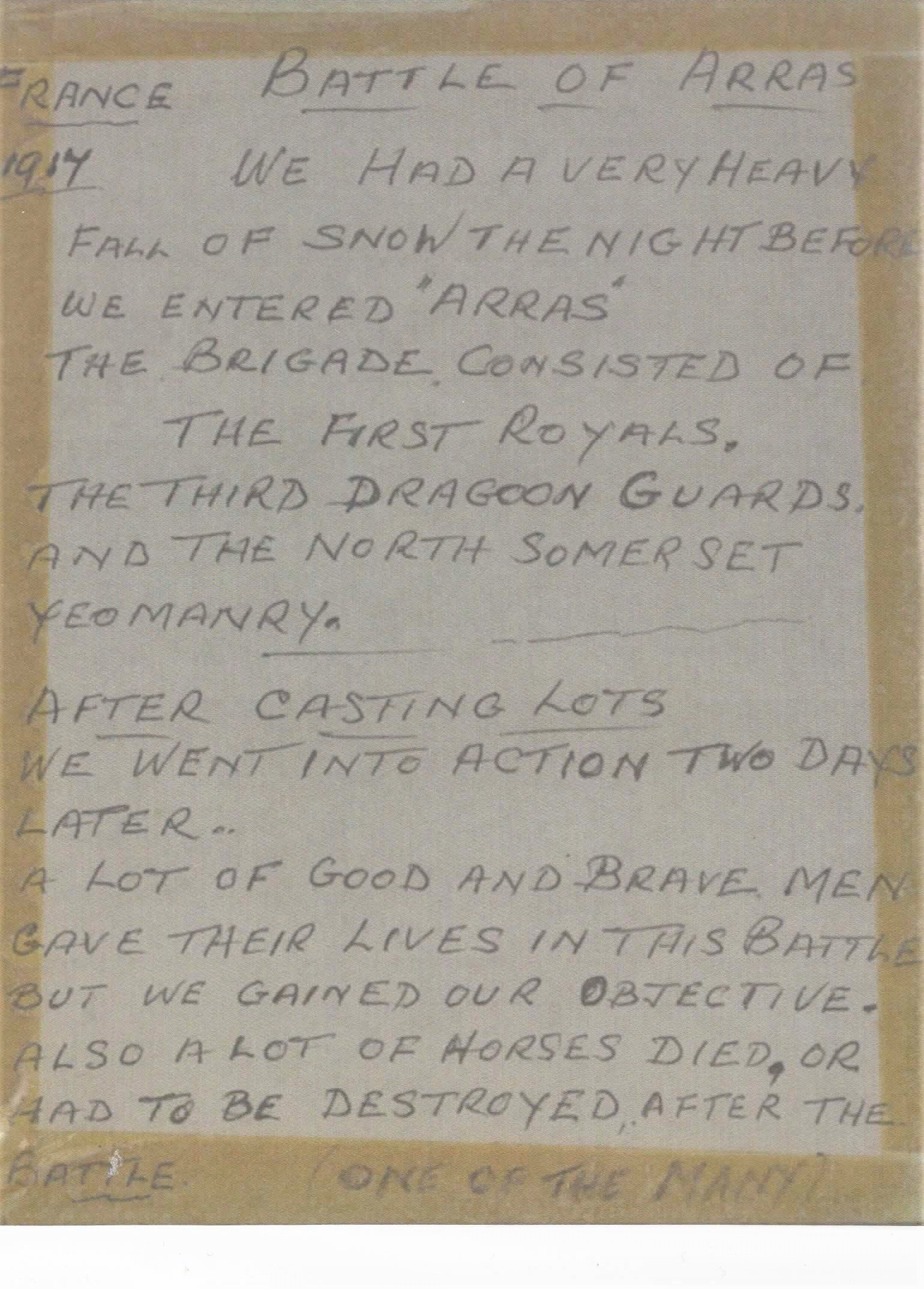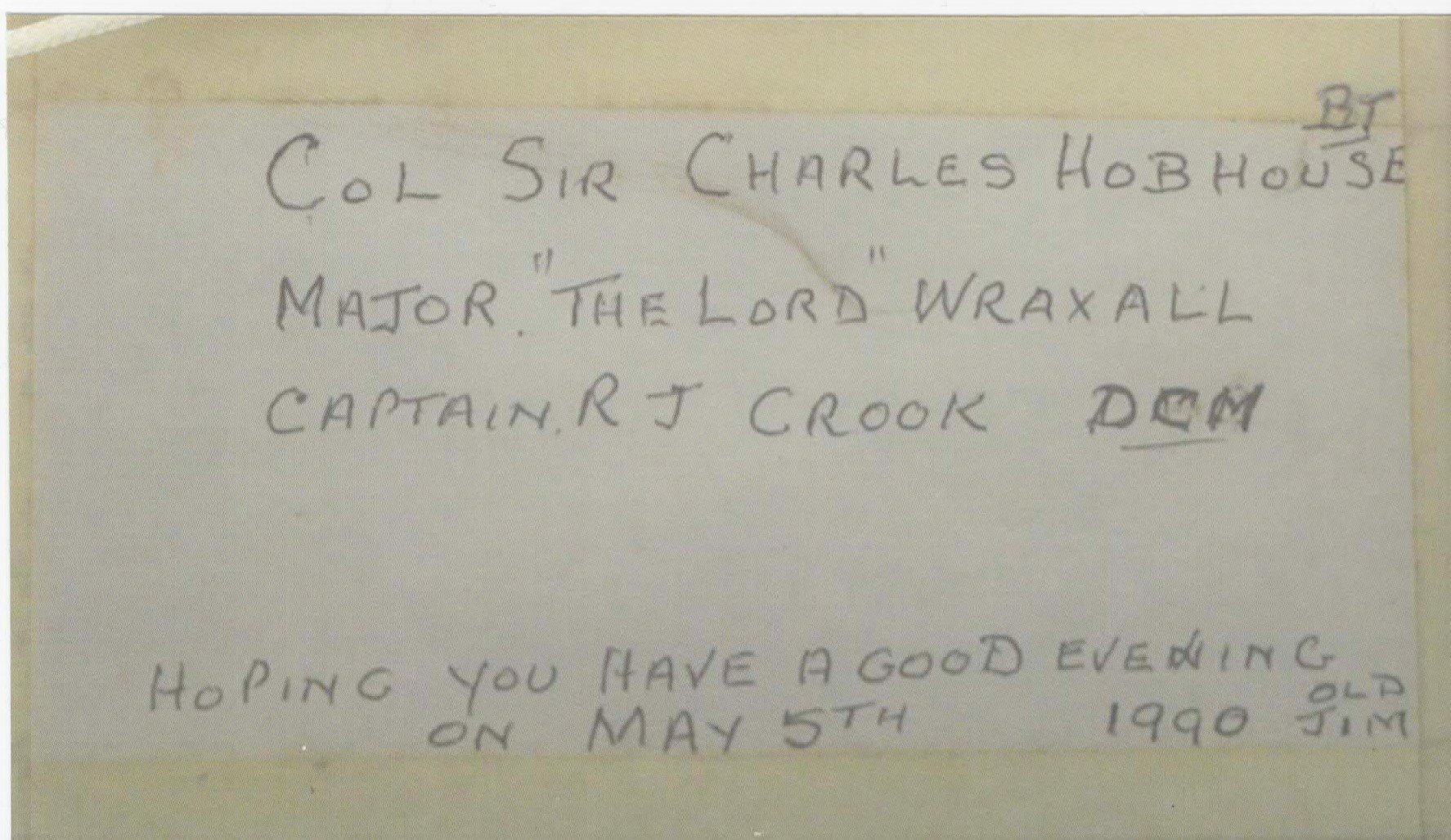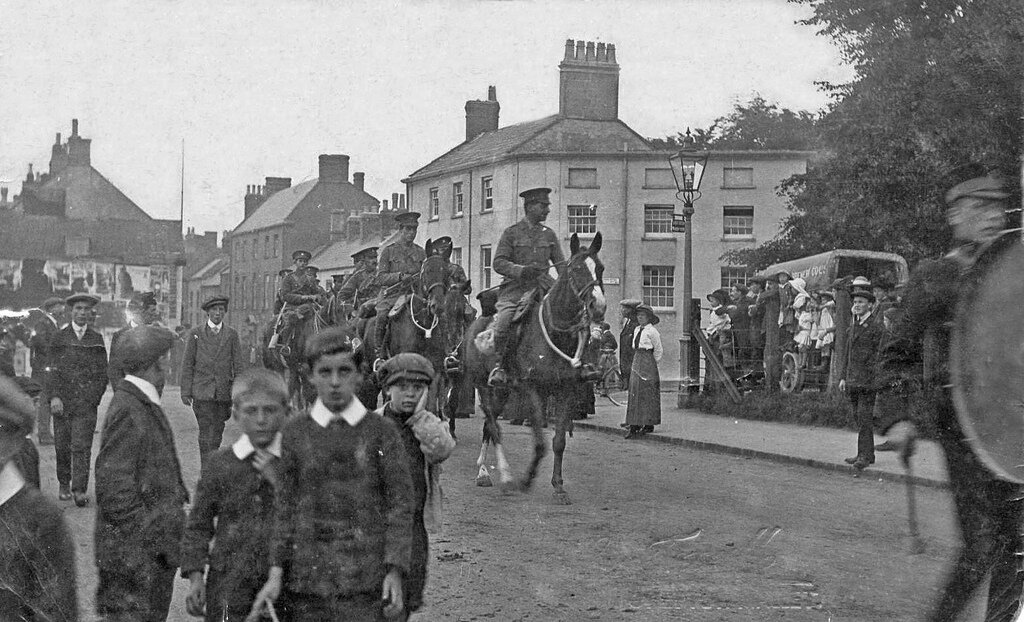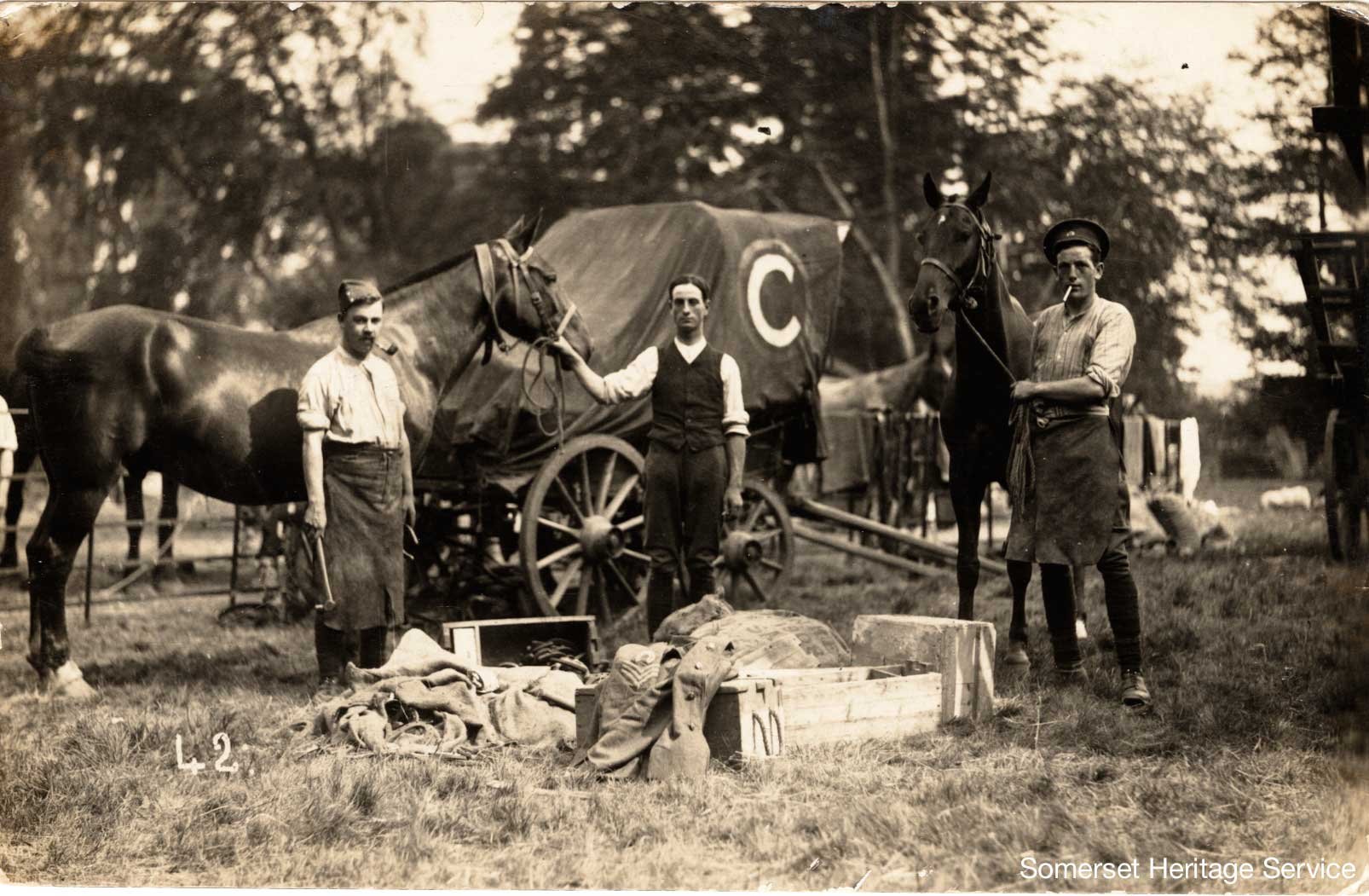The Very Special Painting
When I moved to Somerset in 2014 I slowly began to meet local people and make contacts with similar interests to mine. One of those was a partner in the local antiques shop, his name was Geoff Allen, he is a collector, dealer, local historian and a font of knowledge about the Great War locally. We both have an interest in the NSY and in the past he had acquired a number of medals and items associated with the regiment.
One day when I called into the shop he said he had something for me, he produced a rather childish painting of a battle scene, I wasn’t very impressed but tried to keep it to myself. Geoff then told me of how he came by the painting, a while back he had bought a collection of Yeomanry items from the family of a chap who had died. The painting was part of the collection but had no real monetary value so Geoff stored it away, when he became aware of the work I was doing on the NSY he thought I would be a fit custodian for the painting and handed it to me.
The picture itself is a very simple and naïve version of the Battle of Arras April - May 1917 in which the 6th Cavalry Brigade took part (NSY were part of the Brigade) Painted on board and simply framed it shows the charge by the cavalry of the German trenches with German guns firing at them from positions in front. On the reverse were three pieces of note paper with handwritten notes by the painter. Pte. Richard James DUFTY 1666 NSY was part of the charge on that day.
Here is a short obituary written by Pte. Dufty’s great grandson, it is from my forthcoming Roll of Honour of the NSY in the Great War.
Richard James ‘Jim’ Dufty was born in Bedminster, Bristol on the 21st December 1893. He grew up attending school, and began working part time when he was 12 years old, helping out with domestic duties. Jim left school when he was 14, and soon after began working for the printing company E S & A Robinson.
In May 1915, Jim and his friend Henry ‘Harry’ Blackburn, joined the North Somerset Yeomanry. They arrived in France on the 11th October 1915. Jim served with the 1st/1st North Somerset Yeomanry until they were disbanded in early 1918. He then spent the rest of 1918 serving with the 6th (Inniskilling) Dragoons. In late 1918, Jim was injured in a training exercise, after his horse accidentally toppled onto his leg. He was sent back to England, and was recovering in Liverpool when the Armistice was signed.
After the war, Jim returned to E S & A Robinson, who he had left in 1915. This was where he met Elizabeth ‘Betty’ Pett; they married in 1925. When the Second World War broke out, Jim joined & served in the Home Guard. In 1945, Jim & Betty had a daughter named Barbara. He retired aged 65, after spending almost his entire career with E S & A Robinson. Jim had two grandsons; when they were growing up in the 1970s, Jim would regularly take them out to the local park to play football – something he always loved doing.
His beloved wife Betty passed away in 1984. After living a healthy and happy life, Jim passed away in 1990, aged 96. A brilliant father and grandfather, he was always kind and thoughtful to those around him. Jim, like many of his generation, wasn’t gifted an easy life, but what he did have was the gift of showing the greatest determination, no matter the circumstance, to do the upmost best for himself and his family. He was always a very positive person, even through the hardest of times. The memories of Jim, and the stories that he told, will be cherished forever by his family. “It is better to lose money than to lose a good friend. That is the lesson I have learned in my life.”
James Clements, biography and photographs.
Bristol August 2020
The painting hung on my ‘study’ wall for a number of months until one day I was reading a post on the Great War Forum which mentioned Pte. Dufty, after a little back and forth posting it turned out that it WAS the same chap who had done the painting and that the person doing the research was the Great Grandson. He wasn’t aware of the painting though his father remembered it, believing it to have been lost. I thought for a little while and came to the conclusion that the painting should be returned to the family. I arranged to meet the Grandson, James Clements and his father to hand over the picture and explained that I loved the picture simply for who had painted it and how in his 91st year Jim Dufty still felt the need to tell the story, I hoped that they would enjoy having their family history back.
Recently the Clements family presented me a copy of the painting which is back in the place of honour.
How It All Began
It all begins with an idea.
In 2012 when I was living in West Yorkshire a good friend of mine called me out of the blue.
Me - “Oh hi Steve, how’s you? what can I do for you? “
Steve - “ Fancy doing WW1 cavalry re-enactment? “
Me - “ Yes “
And that’s how my interest in the Yeomanry Cavalry of the Great War of 1914-1918 began and yes I know technically it finished in 1919.
I’ve had an interest in the military and military history since 1982 and the Falklands War, it took place at a very formative period in my life. I’d just left school and was in my first job, I was learning about adult life and this plus lots of great music was a major part. I started by collecting bits of modern militaria, I collected in a scattergun manner, any period any country and after a short time I had a whole load of ex military junk. This left me thinking I needed to find a way to use my ‘junk’ and I started looking around for something to do. I then found a group in a magazine, probably Exchange & Mart of something similar (pre internet days) and dropped them a letter and a few days later a reply arrived on my doorstep with an application form for the WW2 Battle Re-enactment Association (BRA)
I duly sent off my form and a cheque for the membership and waited for a reply. I’d applied to join the US 1st Infantry Division (North) which had members all over the North of England and Southern Scotland. I started collecting the right gear and clothing and took part in my first event at Blackpool Airport in 1983.
I stayed with the BRA for about 4 years until I met my first wife and priorities changed. I sold my kit and settled down to married life.
My wife had always loved horses and so one year I bought her some riding lessons at a local School. I drove her there and watched a couple of times and really wanted to have a go at riding too. Damn I loved it, I loved having the power of a horse, I loved being so high up and controlling such a big beast. I then wondered if I could combine my military interest and riding. In the early 90’s military re-enactment riding was divided into camps, English Civil War and Napoleonic period. I’d never had any interest in the ECW so I found the 15th (Kings) Light Dragoons who were just starting up and offering start up uniform and kit. This sounded perfect so I joined in 1992. The next 8 years saw me spending a fortune on kit and uniform, travelling a lot in the South of England and generally having a great time with the XVLD. 1996 saw the birth of my daughter and a slowing down of events and spending and eventually in 2001 I left XVLD and once again sold my kit (always a bad idea)
A divorce and a second marriage brought me to 2013 and the phone call mentioned at the start of this. In the next blog I’ll talk about my interest in the Yeomanry and how my passion for the North Somerset Yeomanry began.
Why The NSY
It all begins with an idea.
It may seem odd that a chap from the industrial West Riding of Yorkshire would have an interest in a Somerset territorial cavalry regiment so this is how it happened
As mentioned previously I got involved in a Great War Yeomanry re-enactment in 2013. This was the Lancashire Hussars, they served on the Western Front until 1917 when it was dismounted and a large number of its men became the 17th Btn. Kings Liverpool Regiment. I also started researching the Yorkshire Dragoons who had their signals detachment based in my home town. This gave me a start on what the Yeomanry were and how they served.
In 2014 personal circumstances saw me moving to Wells in Somerset. Wells is a beautiful city with over 1000 years of history including a 15th century Tithe Barn. One little fact about this barn was that it was used as a drill hall for the local cavalry and infantry territorials. This peaked my interest and I did a little digging and discovered that Wells had its own troop of the NSY, knowing this and realising that the men of the unit were my neighbours and their families were still living in the city. This excited me more than anything I’d ever done in military history, I also joined another group of re-enactors, Yeoman, who portray the Essex Yeomanry.
I had an idea, to start collecting a Roll of Honour for the men who served with the NSY during the Great War. I searched the various available databases and archives and slowly collected over 1300 names of other ranks who served either in the 1/1st or 2/1st NSY and a large number of officers associated with the regiment. These names are being collated into a 2 volume Roll of Honour which should be published in 2023. A number of these men are pictured on the site below
https://www.thesomersetboys.co.uk/
Please spread the word. There are still a few bits and bobs to add and I will be adding blog posts about the regiment on a regular basis. If you have anything you would like to add just drop me a message.
The First Blood is Shed
It all begins with an idea.
On the 2nd of November 107 years ago the men and Officers of the North Somerset Yeomanry boarded the SS Rosetti at the quay in Southampton and left the safety of the port en-route for Le Havre. They landed at 3pm on the 3rd and set off to a camp 2 and a half miles to the North West of the port. And so began the wartime experience of the Somerset Boys.
The SS Rosetti which carried the NSY to France
The destination was to be the Belgian city of Ypres approximately 350 km to the North East where the regiment were to spend most of the next four years. Over the next two weeks at their billets in Esquerdes they established routines and trained in trench works. They made work parties who travelled through Ypres seeing the still intact Cloth Hall and passed out to the east and the front line. These parties often came under shell fire but were lucky enough not to receive any casualties.
By the 13th of November they were serving in the trenches in support of the front line as part of the 6th Cavalry Brigade alongside the 3rd Dragoon Guards, Royal Dragoons and for a short time the 10th Hussars. At this point the regimental strength was
26 Officers
467 Other Ranks
498 Horses
“On the 15th November, 300 men of the regiment [‘A’ Squadron and troops from ‘B’ Squadron}went into trenches near Ypres. Two hundred of these took over trenches on the Zillebeke-Klienzillebeke Road, whilst the remainder occupied dug-outs near Lord Cavan’s Headquarters. The next day [16th November] passed off comparatively quietly; but the North Somersets were not destined to have a peaceful introduction to war.
At 9am on the 17th November, the Germans began a heavy and continuous bombardment of the sector which they held. At 1pm the Prussian Guards began to advance. Reaching within 20 yards of the British trenches they were met by a terrific burst of rifle and machine gun fire, and crumbled. At 3.45 they advanced once more , this time against the trenches occupied by ‘B’ Squadron NSY and ‘C’ Squadron 3rd Dragoon Guards. The attack was pressed with the utmost determination but like the first it failed. The proudest troops in the German Army retired to their trenches , leaving nearly 400 dead in “ No Mans Land” “
The previous short paragraphs taken from The History of Somerset Yeomanry, Volunteer and Territorial Units by WG Fisher describe in a very matter of fact way what happened on the 17th November 1914 the following extract from the War Diary is just as matter of fact however it does give a list of the casualties suffered by the Regiment in their first taste of battle.
“Zillebeke
9am heavy shelling started and the trenches were searched by shrapnel and HE [high explosive] shells which gave off repulsive fumes. 2 German aeroplanes passed up the lines followed by a 3rd. The trenches had already been damaged by shell fire and as no RE [Royal Engineers] were available they were repaired by the men as best they could but owing to the softness of the soil and no materials for revetting being available the trenches were soon rendered vulnerable again.
A determined attack was made at noon which was repulsed with heavy loss causing the regiment many casualties including Capt Liebert who was killed. The attack was renewed and Brig Gen Lord Cavan was now informed and asked for reinforcements. He sent up 2 coys [companies] Coldstream Gds [Guards] who occupied the reserve trenches at 3.30pm. Meanwhile the attack had been continued and Lt J S Davey killed. 30 men of A Squadron were sent up under Capt R E English to replace casualties. Later on the remainder of A Squadron under Maj G Lubbock was sent up.
The enemy made another determined attack at dusk but was repulsed with heavy loss making it unnecessary to call up the Coldstream Guards. The enemy sent up a balloon at midday with flags attached and in the evening used magnesium light to direct the attack. The relief of the trenches was carried out at 6.30pm by the 2nd Life Guards in the firing line and R[oyal] Horse Guards in reserve. C Squadron came under heavy shell fire in the reserve trenches but did not occupy the front trenches.
The regiment marched dismounted to Ypres where it picked up its horses and returned to its billets near Vlamertinghe.
Casualties - Capt F G C Liebert and Lt J S Davey killed. Capt S G Bates 7th Hussars (adjutant) and 2/Lt A N Bailward wounded. NCOs and men killed 22. Wounded 39. Missing 3. Total casualties 64. Out of these 59 were sustained by the 200 rifles in trenches at Zillebeke.
The weather has been bitterly cold the last few days and the horses suffered from exposure.”
Below is a list of all those killed on the 17th November 1914, there were others who succumbed to wounds in the days following and yet more who were wounded and returned home. I have listed them alphabetically with no mention of rank as they all suffered the same fate together.
“ At the going down of the sun, and in the morning We Will Remember Them”
ADAMS Thomas Francis
BATES S G (7th Hussars)
BRISTOW James Douglas
CARTER Ernest Samuel
CHIVERS Arthur James
CLEAL Alfred Ernest
COMRIE Alexander Peter
CONGDON Ernest Frederick
DAVEY John Stanley
DAVIS Alexander Charles
DICKINSON Leonard Taylor
GEORGE Harold John
GLASS Joseph Egburt
GOODING Harry Charles
HANCOCK Frederick Charles
HARRIS Frank
JACKSON George
LIEBERT Frederick Alexander Charles
McILVEEN Alfred William
POOLE Edward Henry
POPE Wilfred James
RICHARDSON George Wakefield
THOMAS Thomas
TUCKER Francis William
WILSON Wilfred Dick
An Incredibly Rare Film
It all begins with an idea.
Hello again, it’s been a while since I wrote anything here but I have saved a little gem for everyone. Whilst reading Destination Unknown by W Percy Withers he mentions the regiments arrival into East Grinstead en route to Forest Row, apparently the arrival was filmed by a local company and was shown later that day in the local cinema for the soldiers.
I began wondering if the film might possibly exist and started searching various film archives both here and abroad but with no success. I then tried the East Grinstead local pages and museum again with no success or so I thought.
A few days later an email arrived from the University of Brighton, specifically from the Screen Archive asking about the film and where I had found the reference to it. It appears they have a copy of the short film of the NSY arriving in East Grinstead ! It was an amazing feeling knowing that it existed AND it had been digitised and uploaded to their website. They sent a link to the site and with great excitement I clicked the link…
And there they were ‘ C ‘ Squadron North Somerset Yeomanry on film 103 years later. The film was part of a longer section featuring East Grinstead at war. It showed the mounted troops, Officers and NCO’s along with the various waggons of the troop including I believe the Forge waggon seen in the pictures of Ted Garland.
I’m hoping in the future to have a copy of the film to add to the archive I am trying to create but until then here is the link to the film, please enjoy an amazing rare find of a moment in history. (NSY at 3:20)

